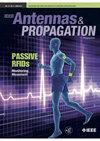长效深层生物电子设备的无线供电:解决方案、限制和新技术[生物电磁学]
IF 5.7
4区 计算机科学
Q2 ENGINEERING, ELECTRICAL & ELECTRONIC
引用次数: 0
摘要
1959年,物理学家理查德·p·费曼(Richard P. Feynman)在美国物理学会(American Physical Society)的一次演讲中提出了一个有远见的想法:“如果你能把外科医生吞下去,那将是外科手术中有趣的事情。”你把机械外科医生放在血管里,然后它进入心脏并“检查”周围。它会找出哪个阀门出了问题,然后拿起一把小刀,把它切下来。其他小型机器可能会被永久植入人体,以帮助某些功能不正常的器官。虽然这个概念在当时看起来很神奇,但随着植入式生物电子学的出现,它已经被证明是有先见之明的。研究人员现在正在设计能够与生物体相互作用的微型电子设备,以收集健康数据,精确地传递药物,或刺激特定的器官或神经。这些进步使更准确的诊断、持续的健康监测以及更有效、侵入性更小的治疗成为可能。在这样做的过程中,生物电子学预示着一种新的医学模式,在这种模式中,设备监测患者的日常生活,促进慢性病的预防保健和长期干预。本文章由计算机程序翻译,如有差异,请以英文原文为准。
Wireless Powering for Long-Lasting Deep-Body Bioelectronic Devices: Solutions, limitations, and new technologies [Bioelectromagnetics]
During a speech to the American Physical Society in 1959, the physicist Richard P. Feynman presented a visionary idea: “It would be interesting in surgery if you could swallow the surgeon. You put the mechanical surgeon inside the blood vessel, and it goes into the heart and ‘looks’ around. […] It finds out which valve is the faulty one and, takes a little knife, and slices it out. Other small machines might be permanently incorporated in the body to assist some inadequately-functioning organ” [1] . Although this concept might have seemed fantastic at the time, it has proven prescient with the emergence of implantable bioelectronics. Researchers are now designing miniaturized electronic devices capable of interacting with living organisms [2] to gather health data, deliver medication precisely, or stimulate a specific organ or nerve. These advancements enable more accurate diagnoses, continuous health monitoring, and also more effective and less invasive treatments. In doing so, bioelectronics are heralding a new paradigm for medicine in which devices monitor patients during daily life and facilitate preventative care and long-term interventions for chronic diseases.
求助全文
通过发布文献求助,成功后即可免费获取论文全文。
去求助
来源期刊

IEEE Antennas and Propagation Magazine
工程技术-工程:电子与电气
CiteScore
7.00
自引率
5.70%
发文量
186
审稿时长
3 months
期刊介绍:
IEEE Antennas and Propagation Magazine actively solicits feature articles that describe engineering activities taking place in industry, government, and universities. All feature articles are subject to peer review. Emphasis is placed on providing the reader with a general understanding of either a particular subject or of the technical challenges being addressed by various organizations, as well as their capabilities to cope with these challenges. Articles presenting new results, review, tutorial, and historical articles are welcome, as are articles describing examples of good engineering. The technical field of interest of the Magazine is the same as the IEEE Antennas and Propagation Society, and includes the following: antennas, including analysis, design, development, measurement, and testing; radiation, propagation, and the interaction of electromagnetic waves with discrete and continuous media; and applications and systems pertinent to antennas, propagation, and sensing, such as applied optics, millimeter- and sub-millimeter-wave techniques, antenna signal processing and control, radio astronomy, and propagation and radiation aspects of terrestrial and space-based communication, including wireless, mobile, satellite, and telecommunications.
 求助内容:
求助内容: 应助结果提醒方式:
应助结果提醒方式:


